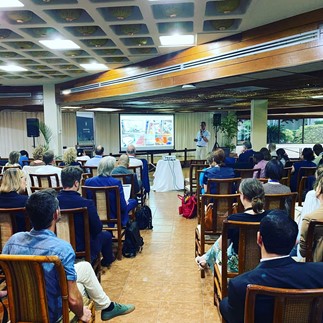
 Last month, FSUCML’s Dr. Jeroen Ingels attended part of the 28th International Seabed Authority (ISA) Council Meeting. At a side event organized by Nauru Ocean Resources Inc., he presented a summary of the work he, Meiolab members, and colleagues at the Federal University of Pernambuco (Recife, Brazil) have been conducting together since 2020. They have been studying spatial and temporal ecological patterns of meiofauna and nematode communities from the abyssal nodule fields of the Clarion Clipperton Fracture Zone in the Pacific. These abyssal areas are of interest because large amounts of polymetallic nodules (usually ~5-20 cm) can be found on the seafloor there. These polymetallic nodules are high-grade metal ore contained in potato-shaped rocks. These nodules are of increasing interest to supply critical metals for batteries and various industries. The specific study area is called NORI-D, an ~25,000 km2 area licensed by the ISA for exploration, which means it is an area that is being studied intensely to establish baseline environmental conditions and to assess the potential impacts that collecting polymetallic nodules may have on abyssal communities that live there. Four benthic research campaigns have been conducted so far and a further fifth one is expected later this year. These campaigns have so far yielded nearly 400 sediment cores (>1000 samples) for meiofauna study only, by far the largest meiofauna study in any single license area in the CCZ. More results, including those based on the polymetallic nodule collector test that was conducted end of 2022, are expected later this year. Stay tuned!
Last month, FSUCML’s Dr. Jeroen Ingels attended part of the 28th International Seabed Authority (ISA) Council Meeting. At a side event organized by Nauru Ocean Resources Inc., he presented a summary of the work he, Meiolab members, and colleagues at the Federal University of Pernambuco (Recife, Brazil) have been conducting together since 2020. They have been studying spatial and temporal ecological patterns of meiofauna and nematode communities from the abyssal nodule fields of the Clarion Clipperton Fracture Zone in the Pacific. These abyssal areas are of interest because large amounts of polymetallic nodules (usually ~5-20 cm) can be found on the seafloor there. These polymetallic nodules are high-grade metal ore contained in potato-shaped rocks. These nodules are of increasing interest to supply critical metals for batteries and various industries. The specific study area is called NORI-D, an ~25,000 km2 area licensed by the ISA for exploration, which means it is an area that is being studied intensely to establish baseline environmental conditions and to assess the potential impacts that collecting polymetallic nodules may have on abyssal communities that live there. Four benthic research campaigns have been conducted so far and a further fifth one is expected later this year. These campaigns have so far yielded nearly 400 sediment cores (>1000 samples) for meiofauna study only, by far the largest meiofauna study in any single license area in the CCZ. More results, including those based on the polymetallic nodule collector test that was conducted end of 2022, are expected later this year. Stay tuned!
Join us every Friday from 11 am - 4 pm for FREE guided tours of FSUCML. No reservations necessary, just stop on by!

